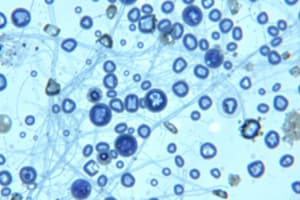Podcast
Questions and Answers
Which microscope is commonly used in veterinary in-house laboratories
Which microscope is commonly used in veterinary in-house laboratories
- Compound (correct)
- Electron
- Dark field
- Phase-contrast
Which microscope is used in research setting or large human medical facilities
Which microscope is used in research setting or large human medical facilities
- Phase-contrast
- Electron (correct)
- Dark field
- Compound light
Which microscope is used in reference laboratories
Which microscope is used in reference laboratories
- Dark field
- Electron
- Phase-contrast
- Both A and C (correct)
What is the maximum optical tube length of the compound light microscope
What is the maximum optical tube length of the compound light microscope
Which of the following is the distance between the objective lens and the eyepiece
Which of the following is the distance between the objective lens and the eyepiece
The total magnification of the compound light microscope is calculated by multiplying the ocular magnification by the objective magnification power. Identify the correct example
The total magnification of the compound light microscope is calculated by multiplying the ocular magnification by the objective magnification power. Identify the correct example
Which of the following solvents is used for care and maintenance of the compound light microscope
Which of the following solvents is used for care and maintenance of the compound light microscope
[Compound light microscope] What can be used to remove excessive oil
[Compound light microscope] What can be used to remove excessive oil
Can you use oil on the slide when using the high-dry objective lens
Can you use oil on the slide when using the high-dry objective lens
Can you use the coarse adjustment knob to focus on the specimen while the high-power lens is in place
Can you use the coarse adjustment knob to focus on the specimen while the high-power lens is in place
When to use course adjustment knob
When to use course adjustment knob
When using the x100 (oil-immersion) objective lens, what is the first step
When using the x100 (oil-immersion) objective lens, what is the first step
When using the x100 (oil-immersion) objective lens, what is the second step
When using the x100 (oil-immersion) objective lens, what is the second step
Scanning
Scanning
When using the x100 (oil-immersion) objective lens, what is the third step
When using the x100 (oil-immersion) objective lens, what is the third step
When using the x100 (oil-immersion) objective lens, what is the fourth step
When using the x100 (oil-immersion) objective lens, what is the fourth step
When using the x100 (oil immersion) objective lens, what is the fifth step
When using the x100 (oil immersion) objective lens, what is the fifth step
When using the x100 (oil-immersion) objective lens, what is the sixth step
When using the x100 (oil-immersion) objective lens, what is the sixth step
Low power
Low power
High-dry
High-dry
Oil-immersion
Oil-immersion
Low oil-immersion
Low oil-immersion
Supports both the oculars and the rotating nosepiece containing the objective lenses. Through a system of mirrors within, it projects the image from the objective lens to the eyepiece
Supports both the oculars and the rotating nosepiece containing the objective lenses. Through a system of mirrors within, it projects the image from the objective lens to the eyepiece
Vertical portion of the microscope connecting the base to the head.
Vertical portion of the microscope connecting the base to the head.
Used to make large adjustments in the distance between the specimen and the objective lens to focus on the specimen
Used to make large adjustments in the distance between the specimen and the objective lens to focus on the specimen
Used to make small or fine, adjustments in the distance between the specimen and the objective lens to focus on the specimen. It is used for precise focusing
Used to make small or fine, adjustments in the distance between the specimen and the objective lens to focus on the specimen. It is used for precise focusing
Contains a lens that focuses light on the specimen. It may have a height-adjustment knob that raises and lowers it (and the lens) to vary the light delivery. Generally, the best position for it is dose to the bottom surface of the stage.
Contains a lens that focuses light on the specimen. It may have a height-adjustment knob that raises and lowers it (and the lens) to vary the light delivery. Generally, the best position for it is dose to the bottom surface of the stage.
This contains three or four objective lenses, which are changed by rotating the desired lens into the proper position over the specimen. It should be used to rotate the lens rather than grabbing the lenses themselves
This contains three or four objective lenses, which are changed by rotating the desired lens into the proper position over the specimen. It should be used to rotate the lens rather than grabbing the lenses themselves
As the arm, or lever, attached to the condenser is moved, which of the following opens and closes to permit a variable amount of light to pass through the condenser. It provides the best possible contrast for viewing a specimen
As the arm, or lever, attached to the condenser is moved, which of the following opens and closes to permit a variable amount of light to pass through the condenser. It provides the best possible contrast for viewing a specimen
Consists of two lenses that focus light from the light source on the object
Consists of two lenses that focus light from the light source on the object
Opens and closes to control the amount of light illuminating the object
Opens and closes to control the amount of light illuminating the object
Flashcards are hidden until you start studying




